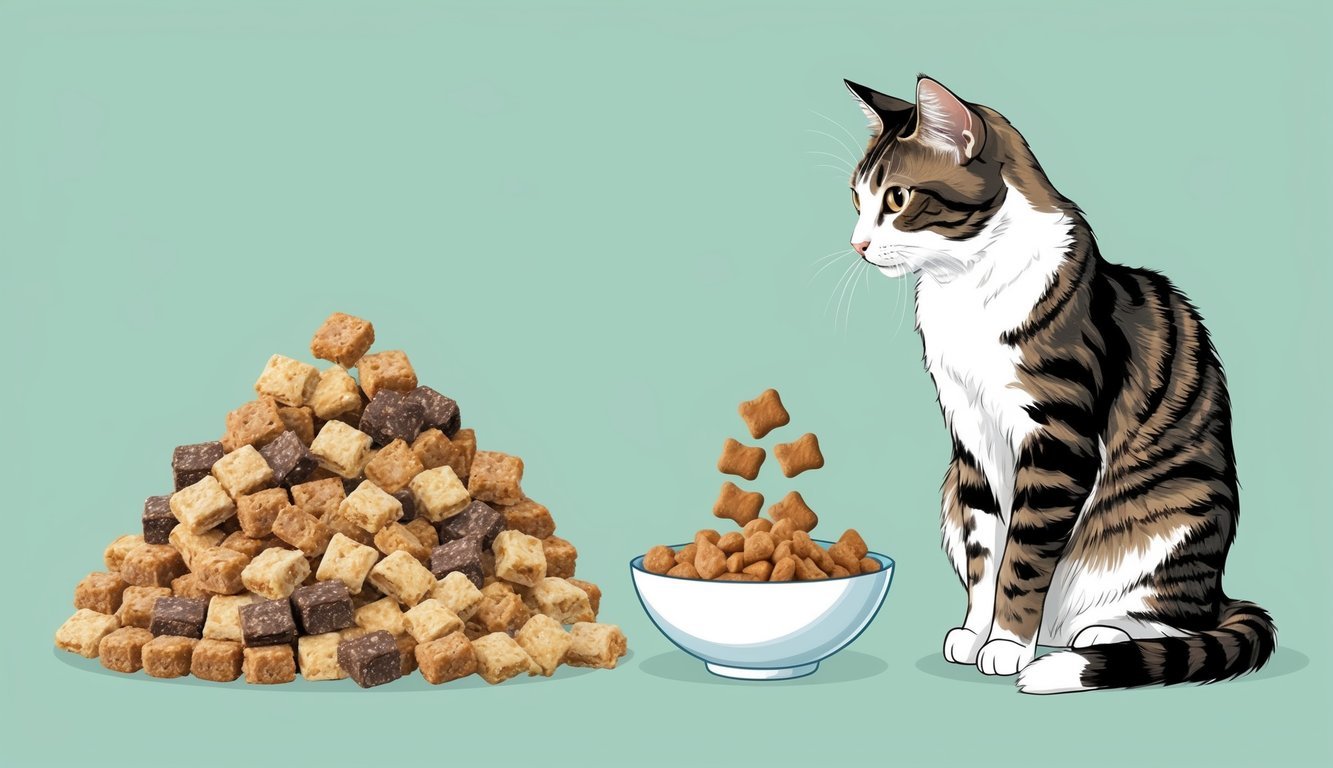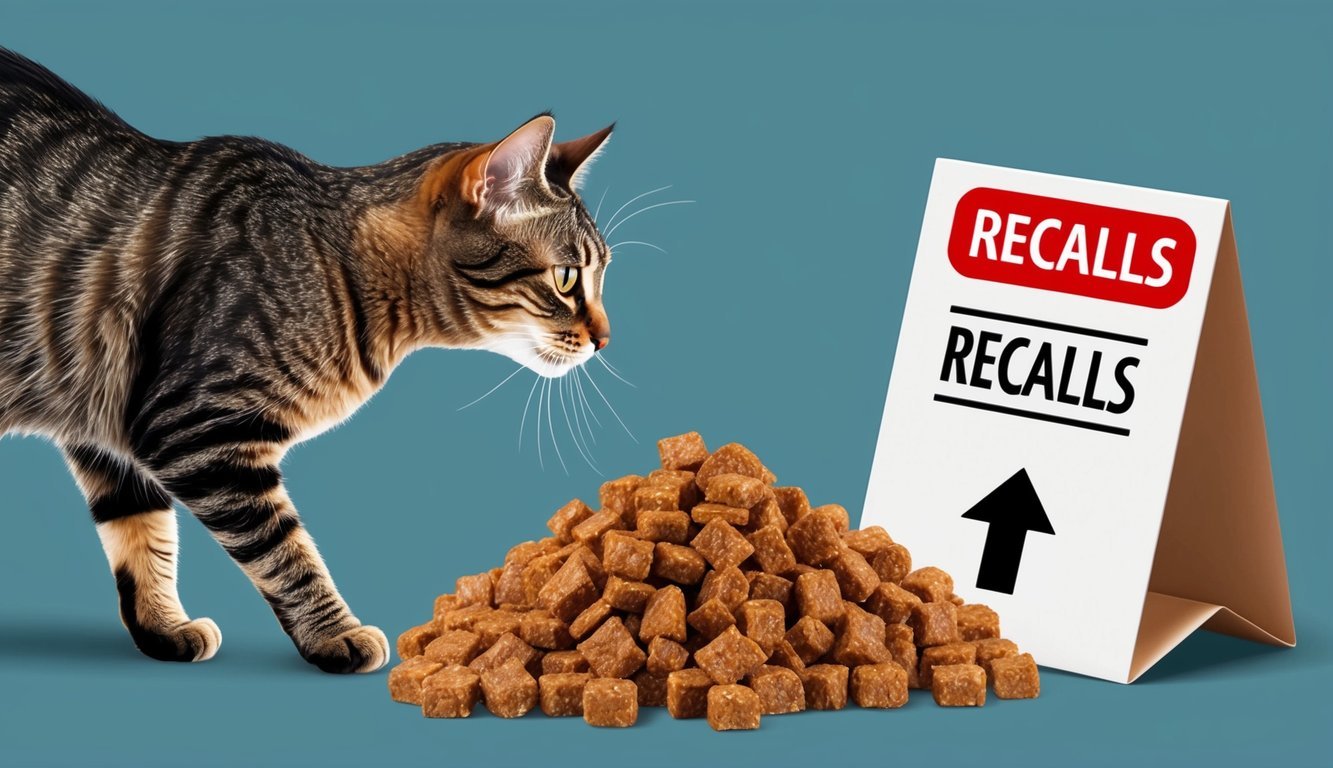The question of whether Temptations treats are bad for cats is a common concern among pet owners.
Many cats end up favoring these treats over their regular food, which could lead to imbalanced diets and health issues.
Veterinarians have pointed out that Temptations are high in protein and designed to stimulate a cat’s pleasure centers, similar to how unhealthy snacks affect humans.
This can result in a craving that may alter your cat’s eating habits.
It’s crucial to be mindful of how these treats fit into your cat’s overall diet and behavior patterns.
As you navigate the choices available for your feline friend, understanding the impact of various treats can help you make informed decisions.
Balance and moderation are key, so you can ensure that your cat enjoys their treats without compromising their health.
Key Takeaways
- Temptations treats are appealing but should be given in moderation.
- Consider your cat’s overall diet when offering commercial treats.
- Monitor your cat’s behavior and health for any changes related to treat consumption.
Understanding Cat Treats
Cat treats play a significant role in your feline’s life, both in terms of diet and behavior.
Knowing the different options available and the importance of moderation can help you make better decisions for your pet’s health and happiness.
Role of Treats in Feline Diet
Treats serve several purposes in a cat’s diet.
They can act as motivational rewards during training or simply as a way to strengthen your bond with your pet.
While treats should not replace nutritionally complete meals, they can enhance mealtime experience.
It’s essential to choose treats that provide some nutritional value.
Look for options that include protein as a primary ingredient.
High-quality treats can contribute positively to your cat’s overall diet, but remember, they should be supplementary.
Popular Treat Options
There is a wide variety of cat treats available, ranging from crunchy bites to soft chews.
Here are a few popular options:
- Temptations: Known for their addictive nature, they come in various flavors but can be high in calories.
- Freeze-Dried Treats: These typically contain single protein sources, providing essential nutrients without fillers.
- Dental Chews: These help promote dental health while satisfying your cat’s chewing instinct.
When selecting treats, consider your cat’s health needs.
For example, if your cat is overweight, look for low-calorie options.
Need for Moderation in Treats
Moderation is crucial when it comes to cat treats.
Too many treats can lead to health issues such as obesity and diabetes.
It’s vital to limit treats to about 10% of your cat’s daily caloric intake.
Make sure to read the packaging for serving sizes and nutritional information.
Balancing treats with regular meals keeps your cat healthy.
A good approach is to use treats as rewards or during special occasions, ensuring that they remain a fun part of your cat’s routine rather than a regular staple.
Analysing Temptations Treats

Temptations Treats are a popular choice among cat owners, manufactured by MARS, a well-known brand in pet food.
Understanding the brand, its ingredients, and different product variants can help you make informed decisions about your cat’s diet.
Temptations Brand Overview
Temptations is widely recognized for its crunchy exterior and soft, meaty centers.
These treats are designed to appeal to your cat’s taste preferences, and they attract many pets due to their flavor.
The brand markets these treats as a delightful snack for your feline friends, emphasizing that they are both fun and tasty.
Given their popularity, it’s important to look at how Temptations fit into your cat’s overall nutrition.
While they can be enjoyed occasionally, they should not replace a balanced diet.
Ingredients and Nutritional Profile
The ingredients in Temptations Treats include meat by-products, ground corn, wheat flour, and animal fat.
While they provide a protein-rich option, some components like meat by-products may not appeal to all pet owners.
Each treat typically contains fewer than 2 calories, which makes them a lightweight option for snacks.
Temptations are enhanced with taurine, an essential amino acid beneficial for your cat’s heart and vision.
However, be aware of additives such as Red #40 and the implications of feeding processed treats regularly.
Staying mindful of your cat’s overall diet ensures they maintain good health while enjoying these flavors.
Temptations Product Variants
Temptations offers a variety of flavors and textures to keep things interesting for your cat.
Popular options include MixUps like “Surfer’s Delight,” featuring seafood flavors that many cats find irresistible.
Each variant provides a unique taste and texture, catering to different preferences.
You might notice that each type has varying ingredients.
Some could contain additional flavor enhancers or different protein sources.
When choosing a variant, consider your cat’s dietary sensitivities and preferences.
This way, you can select treats that bring joy without compromising their health.
Health Considerations for Cats
When it comes to feeding your cat treats like Temptations, it’s essential to consider their health in various aspects.
Paying attention to dental health, managing weight, addressing potential allergies, and being aware of digestive issues can significantly impact your feline friend’s well-being.
Importance of Dental Health
Maintaining your cat’s dental health is crucial.
Treats high in sugars and carbohydrates can contribute to plaque buildup, leading to gum disease and tooth decay.
Cats that consume a diet solely made up of soft treats may not get the necessary abrasion to keep their teeth clean.
To help support dental health, consider incorporating crunchy treats or dry kibble.
You should also schedule regular veterinary check-ups for dental cleanings. Daily brushing can also make a significant difference if you can get your cat accustomed to it.
Remember, healthy teeth equate to a happier kitty.
Managing Weight Gain and Obesity
Obesity in cats is a growing concern.
High-calorie treats like Temptations can lead to weight gain, especially if given in excess.
According to veterinarians, overweight cats are at a higher risk for developing serious health issues, including diabetes and joint problems.
To manage your cat’s weight, it’s essential to monitor treat portions.
A general guideline is to limit treats to 10% of their daily caloric intake.
Opt for lower-calorie alternatives if your cat craves something extra.
Encourage playtime to keep them active, which can help maintain a healthy weight.
Potential Allergies and Sensitivities
Some cats may experience food allergies or sensitivities that manifest as skin irritations, gastrointestinal upset, or other health problems.
Ingredients in Temptations, such as various proteins and fillers, can trigger allergic reactions.
If you notice unusual behavior or symptoms after introducing new treats, consult your veterinarian.
Keeping track of specific ingredients that might upset your cat’s stomach or skin can help you choose the right products in the future.
Look for treats labeled hypoallergenic if sensitivities are a concern.
Dealing with Digestive Issues
Digestive issues in cats can stem from various food-related problems.
High-fat treats can lead to vomiting or diarrhea, especially if your cat has a sensitive stomach.
It’s essential to observe how your cat reacts to Temptations.
If your cat occasionally experiences digestive discomfort, consider offering smaller portions of treats or switching to gentler options.
Always provide plenty of fresh water, as hydration can also aid digestion.
If issues persist, a consultation with your vet may be necessary to determine underlying causes.
Feeding Practices for Owners
It’s essential to manage how you feed your cat treats while ensuring a balanced diet.
Understanding the right practices can help you prevent treat-related issues and promote a healthier lifestyle for your feline friend.
Recommended Feeding Guidelines
Start by setting clear boundaries on treat consumption.
A good rule of thumb is that treats should make up no more than 10% of your cat’s daily calorie intake.
Pay close attention to portion sizes and consider using a measuring spoon to avoid overindulgence.
You can also check the nutritional information on treat packaging to understand better their impact on your cat’s diet.
Opt for treats with lower fat and calories to keep your cat healthy.
Make sure to pair treats with a nutritious regular diet.
Wet food or high-quality dry food can contribute significantly to their health when managed correctly.
Recognizing and Addressing Overindulgence
Watch for signs of treat addiction in your cat, such as begging, vocalization, or changes in eating habits.
If your cat seems fixated on treats, it may lead to obsessive behavior.
To counteract this, you might consider offering treats only during specific times of day, making them a reward rather than a constant option.
If your cat exhibits anxiety or stress without treats, consult a veterinarian for tailored advice.
Creating a healthy routine can help alleviate these issues.
Regular feeding schedules with designated meal times can reduce the likelihood of overindulgence while providing your cat structure.
Interactive Playtime and Treats
Combining interactiveness with treat-giving can be beneficial.
Use treat-dispensing toys during playtime.
This not only enhances engagement but also helps manage portion control.
Set aside play sessions where you reward your cat with occasional treats for completing tasks or responding to commands.
This reinforces positive behavior while keeping your cat physically active.
Remember that interaction is key.
Engaging your cat through play, rather than allowing continuous access to treats, can prevent behavioral problems.
By using treats wisely, you pave the way for a healthier, happier feline companion.
Alternatives to Commercial Treats

If you’re looking for healthier options for your cat besides commercial treats like Temptations, there are several alternatives to consider.
You can make homemade treats, explore natural selections, or utilize cat food toppers to provide your feline friend with flavorful and wholesome snacks.
Homemade Treat Recipes
Making homemade treats allows you to control the ingredients your cat consumes.
Simple recipes like chicken or fish treats are popular choices.
Here’s a straightforward approach:
-
Ingredients:
- 1 cup cooked chicken or fish
- 1 egg
- 1/4 cup oat flour
-
Instructions:
- Preheat your oven to 350°F (175°C).
- Blend the chicken or fish, egg, and oat flour until it forms a dough.
- Roll into small balls or flatten into shapes.
- Bake for 15-20 minutes or until golden.
These treats are packed with natural ingredients and can easily be customized with various meats or even catnip for extra flavor.
Natural and Organic Choices
When considering alternatives, natural and organic treats offer a great way to ensure your cat enjoys quality snacks.
Look for options like freeze-dried meat or options with minimal processing.
- Benefits:
- Made from real meat with no fillers.
- Often available in convenient bite-sized pieces.
Check labels for organic certifications to avoid artificial flavors and preservatives.
Many pet brands offer a range of organic treats featuring single protein sources, like turkey or lamb, appealing to your cat’s natural instincts.
Using Cat Food Toppers
Cat food toppers can add excitement to your cat’s meal without using traditional treats.
These products enhance the flavor of regular cat food.
- Types of Toppers:
- Meat-based gravy
- Freeze-dried meat crumbles
- Broths
Toppers can bring a new texture and taste that can entice even the pickiest eaters.
You just sprinkle or mix a small amount into your cat’s food to provide a delicious boost.
This can keep your cat engaged at mealtime while promoting healthy eating habits.
Safety and Recalls

When choosing treats for your cat, you should always prioritize safety.
Being aware of a product’s recall history and understanding how to ensure treat safety can help you make informed decisions for your furry friend.
Understanding Recall History
The recall history of Temptations treats is significant for pet owners.
A notable incident occurred on February 3, 2023, when the company announced a voluntary recall due to potential salmonella contamination.
This contaminant was detected at the manufacturing facility during routine testing.
Salmonella can affect not only pets but also humans, leading to serious health risks.
Symptoms in infected cats may include vomiting, diarrhea, and fever.
Staying updated on recall announcements is crucial for the safety of your pets.
Ensuring Treat Safety
To keep your cat safe while enjoying treats, follow these tips.
First, always check for recalls by visiting the manufacturer’s website or reliable pet safety resources.
Make it a habit to look for any announcements related to Temptations or other brands.
Second, monitor your cat for any signs of illness after eating treats.
Common symptoms include changes in appetite or behavior.
Also, consider using treats as an occasional reward rather than a daily staple.
This reduces the risk of health issues associated with excessive consumption.
Lastly, always choose products that have clear ingredient lists, avoiding those with questionable additives.
This way, you can offer your cat safe and enjoyable treats without unnecessary risks.
Selecting the Right Treats
Choosing the right treats for your cat can greatly impact their health and happiness.
You’ll want to focus on the quality of ingredients and how treats fit into their overall diet.
Assessing Treat Quality
When selecting treats, look for those with high-quality ingredients.
Check for a solid protein source, such as chicken, turkey, or fish.
Avoid treats that list artificial colors or preservatives.
Consider the texture of the treats.
Crunchy options can help support dental health, reducing tartar buildup as your cat chews.
Pay attention to the nutritional information; many treats have added taurine, which is essential for feline health.
Be cautious of treats that cause side effects like diarrhea or vomiting.
Cats have sensitive stomachs, so you may want to introduce new treats gradually.
Treats as Part of a Balanced Diet
Treats should be given in moderation.
They should complement your cat’s regular diet, not replace it.
Too many treats can lead to obesity and related health issues.
The cat food you choose, such as Whiskas or a premium brand, should provide a balanced diet emphasizing proteins, fats, and essential vitamins.
Calculate the treat-to-food ratio.
A good rule of thumb is that treats should make up no more than 10% of your cat’s daily caloric intake.
Keeping track of this can help you maintain your cat’s health and prevent them from developing a strong preference for treats over their main meals.
Conclusion

Deciding whether Temptations treats are bad for your cat involves several factors.
While they are popular and appealing, they come with concerns.
Consider the ingredients: Many Temptations treats contain additives like flavoring agents and high levels of fat, salt, and sugar.
These components can lead to health issues if given in excess.
Behavioral impacts: Some cats may become dependent on these treats, leading to begging or increased meowing.
It’s important to monitor any changes in your cat’s behavior.
Moderation is key: If you choose to give your cat Temptations, do so sparingly.
Consulting with your vet can help you find a balanced approach that suits your pet’s needs.
Alternatives exist: There are many healthier treat options on sites like Chewy.com that can be beneficial for your furry friend.
Explore those to maintain your cat’s health while rewarding them.
Frequently Asked Questions

You’ve likely got some questions about Temptations treats and their impact on your cat’s health.
Here are some common inquiries to help you understand the potential risks and considerations involved.
What are the potential side effects of cats eating Temptations treats?
Some common side effects include weight gain, digestive upset, or changes in behavior due to the high protein content and additives.
If your cat consumes these treats excessively, it may lead to obesity and related health issues.
Has there been a recall on Temptations cat treats recently?
Yes, there have been occasional recalls related to Temptations treats.
It’s always good to check the manufacturer’s website or pet food recall databases for the most current information and ensure the safety of the products you purchase.
Is there a connection between Temptations treats and feline urinary tract infections?
While there’s no direct proven link, some ingredients may contribute to dietary issues that can affect urinary health.
High levels of certain minerals in treats can lead to urinary tract problems if consumed in excess, so moderation is key.
Are there any legal actions or lawsuits against Temptations treats due to health concerns for cats?
As of the latest information, there have been no prominent legal actions or lawsuits specifically targeting Temptations treats.
However, it’s wise to stay informed about any potential issues that may arise with pet foods.
What ingredients are in Temptations cat treats, and are they considered safe?
Temptations treats contain ingredients like flavoring agents, corn, and preservatives.
While some components are safe in moderation, always read the label and consult with your vet if you have concerns about specific ingredients.
How much of Temptations treats is safe for a cat to consume daily?
You should limit treats to about 15 per 10 pounds of your cat’s body weight per day.
Always keep portion control in mind to maintain your cat’s health and well-being.

